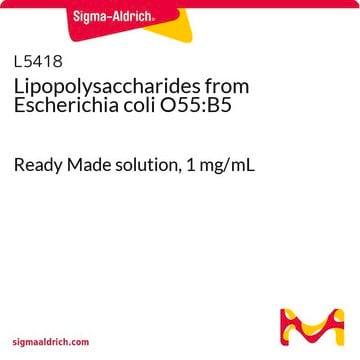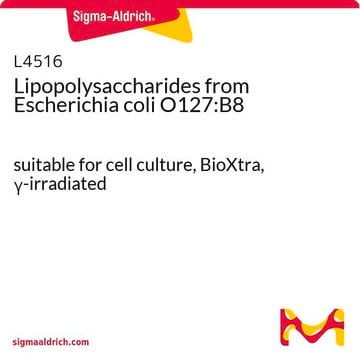L5293
Lipopolissacarídeos
Ready Made solution, 1 mg/mL
Sinônimo(s):
LPS
About This Item
Produtos recomendados
fonte biológica
Escherichia coli (O111:B4)
Nível de qualidade
forma
aqueous solution
concentração
1 mg/mL
cor
colorless to faint yellow
solubilidade
water: soluble
Condições de expedição
wet ice
temperatura de armazenamento
2-8°C
Procurando produtos similares? Visita Guia de comparação de produtos
Aplicação
- to stimulate an inflammatory response in porcine liver tissues in-vivo and piglet ileum tissues ex vivo
- to stimulate Ex vivo natural killer(NK) cells and hepatic B cells
- to induce arthritis in a standard rabbit model
Ações bioquímicas/fisiológicas
Nota de preparo
Outras notas
produto relacionado
Código de classe de armazenamento
12 - Non Combustible Liquids
Classe de risco de água (WGK)
WGK 1
Ponto de fulgor (°F)
Not applicable
Ponto de fulgor (°C)
Not applicable
Equipamento de proteção individual
Eyeshields, Gloves, multi-purpose combination respirator cartridge (US)
Certificados de análise (COA)
Busque Certificados de análise (COA) digitando o Número do Lote do produto. Os números de lote e remessa podem ser encontrados no rótulo de um produto após a palavra “Lot” ou “Batch”.
Já possui este produto?
Encontre a documentação dos produtos que você adquiriu recentemente na biblioteca de documentos.
Os clientes também visualizaram
Artigos
Explore the structure, function, and diverse applications of Lipopolysaccharides. Discover their role in bacteria, serological specificity, and research potential.
Conteúdo relacionado
Lipopolysaccharide (LPS) is a major component of Gram-negative bacteria, important for microbiological research.
Nossa equipe de cientistas tem experiência em todas as áreas de pesquisa, incluindo Life Sciences, ciência de materiais, síntese química, cromatografia, química analítica e muitas outras.
Entre em contato com a assistência técnica



